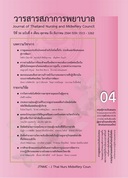การศึกษาลักษณะครอนอไทป์ และความต้องการรูปแบบการจัดตารางการปฏิบัติงานของพยาบาล โรงพยาบาลสังกัดมหาวิทยาลัย
คำสำคัญ:
ครอนอไทป, ความต้องการรูปแบบการจัดตารางการปฏิบัติงาน, พยาบาล, โรงพยาบาลบทคัดย่อ
วัตถุประสงค์การวิจัย: เพื่อศึกษาลักษณะครอนอไทป์ และความต้องการรูปแบบการจัดตารางการปฏิบัติงานของพยาบาล
การออกแบบการวิจัย: การวิจัยเชิงพรรณา (descriptive study)
วิธีดำเนินการวิจัย: กลุ่มตัวอย่างเป็นพยาบาล จำนวน 831 คน ปฏิบัติงานหมุนเวียนแบบผลัด อายุงาน 1 ปีขึ้นไป ปฏิบัติงานเวร บ่าย/ดึก อย่างน้อย 1 เวรต่อเดือน สังกัดฝ่ายการพยาบาล โรงพยาบาล สังกัดมหาวิทยาลัย เก็บรวบรวมข้อมูลจากแบบสอบถามผ่าน Google Form แบบสอบถามประกอบด้วย 3 ส่วน คือ ข้อมูลส่วนบุคคลความต้องการรูปแบบการจัดตารางการปฏิบัติงาน และแบบวัด Morningness - Eveningness Questionnaires ฉบับภาษาไทย (T-MEQ) วิเคราะห์ข้อมูลโดยใช้จำนวน ร้อยละ และ สถิติทดสอบไคสแควร์ (chi-squared test)
ผลการวิจัย: พยาบาลจำนวน 831 คน ส่วนใหญ่มีลักษณะครอนอไทป์เป็นอินเทอมิเดียไทป์ (ร้อยละ 64.7) ซึ่งมีความสัมพันธ์กับความต้องการการปฏิบัติงานเหลื่อมเวลาเวรดึก การปฏิบัติงาน 10 ชั่วโมงต่อวัน การปฏิบัติงานแบบเวรเดียวตลอด ประสบการณ์ในการทำงานประเภทผู้ป่วยที่ดูแล สถานภาพสมรส และภาระที่ต้องรับผิดชอบ อย่างมีนัยสำคัญทางสถิติ (p<0.05)
ความต้องการรูปแบบการจัดตารางการปฏิบัติงานส่วนใหญ่พยาบาลมีความต้องการปฏิบัติงานเวรเช้า (ร้อยละ 51.4) ปฏิบัติงานเหลื่อมเวลาเวรเช้า (ร้อยละ 73.9) และต้องการเลือกวันหยุดได้ด้วยตนเอง (ร้อยละ 93.5) พยาบาลส่วนใหญ่ไม่ต้องการหมุนเวียนหน่วยงาน (ร้อยละ 90.5) และไม่เลือกปฏิบัติงานแบบเวรเดียวตลอด (ร้อยละ 65.8)
ประสบการณ์ในการทำงาน ประเภทผู้ป่วยที่ดูแล สถานภาพสมรสและภาระที่ต้องรับผิดชอบมีความสัมพันธ์กับความต้องการรูปแบบการจัดตารางการปฏิบัติงานในการขึ้นเวรผลัด และการปฏิบัติงานแบบเวรเดียวตลอด อย่างมีนัยสำคัญทางสถิติ (p<0.05)
ข้อเสนอแนะ:ผู้บริหารองค์กรควรสอบถามลักษณะครอนอไทป์ ความต้องการรูปแบบการจัดตารางการปฏิบัติงานและเปิดโอกาสให้พยาบาลได้เลือกเวรที่ต้องการและปรับรูปแบบการจัดเวรให้มีความยืดหยุ่น
Downloads
เอกสารอ้างอิง
Muecke S. Effects of rotating night shifts: literature review. J Adv Nurs. 2005 May;50(4):433-9. doi: 10.1111/j.1365-2648.2005.03409.x. PMID: 15842451.
Ruangtrakul S. Sleep disorders assessment and treatment. Bangkok: Ruen Kaew Printing; 2007. (in Thai)
Cappadona R, Di Simone E, De Giorgi A, Boari B, Di Muzio M, Greco P, et al. Individual circadian preference,
shift work, and risk of medication errors: a cross-sectional web survey among Italian midwives. Int J Environ Res
Public Health. 2020 Aug 11;17(16):5810. doi: 10.3390/ijerph17165810. PMID: 32796648; PMCID: PMC7460124.
Hongwaranon Kanjana. A study of the circadian type and shift work to fatigue among shift-working nurses
at Phatthalung Hospital. Phatthalung Hospital [Master of Science thesis]. Songkhla: Prince of Songkla University; 2559. (in Thai)
Khunthar A, Thongchareon V, Namthep J, Klayklongjit S. Predicting factors of intent to stay among professional
nurses in a university hospital. Journal of Nursing Science. 2012;30(4):7-17. (in Thai)
International Workplace Group. The annual IWG global workspace survey welcome to generation flex – the employee power shift. International Workplace Group .March 2019.
Horne JA, Ostberg O. A self-assessment questionnaire to determine Morningness - Eveningness uestionnaires,
in human circadian rhythms. Int J Chronobiol. 1976; 4(2): 97-110.
Ngamjarus C, Chongsuvivatwong V, McNeil E, Holling H. Enhancement of learning on sample size calculation
with a smartphone application: A cluster-randomized controlled trial. Southeast Asian J Trop Med Public Health. 2017.
Udomrat P, Yodprom P, Chusong T. Sensitivity and specifcity of the Thai - Morningness Eveningness Questionnaire (T-MEQ) in relation to the daily body temperature. Journal of Psychiatric Association of
Thailand. 2007; 52 (4): 352-67. (in Thai)
Tankova I, Adan A, Buela CG. Circadian typology and individual differences. A review. Personality and individual differences. 1994 May 16(5): 671-684. doi.org/10.1016/0191-8869(94)90209-7.
Rodwell J, Fernando J. Managing work across shifts: not all shifts are equal. J Nurs Scholarsh. 2016 Jul;
(4):397-405. doi: 10.1111/jnu.12220. Epub 2016 May 26. PMID: 27228576.
Silva RMD, Zeitoune RCG, Beck CLC, Martino MMF, Prestes FC, Loro MM. Chronotype and work shift in nursing workers of university hospitals. Rev Bras Enferm. 2017 Sep-Oct;70(5):958-964. doi: 10.1590/ 0034-7167-2016-0542. PMID: 28977221.
Reinke L, Özbay Y, Dieperink W, Tulleken JE. The effect of chronotype on sleepiness, fatigue, and psychomotor
vigilance of ICU nurses during the night shift. Intensive Care Med. 2015 Apr;41(4):657-66. doi: 10.1007/ s00134-015-3667-7. Epub 2015 Feb 12. PMID: 25672276; PMCID: PMC4392115.
Rerkluenrit J, Kodchakri R. A Study of the Relationship between selected personal factors, professional practice environment and job satisfaction of registered nurses in Thailand. Srinagarind medical Journal. 2019;34(3):287-92. (in Thai)
Stimpfel AW, Sloane DM, Aiken LH. The longer the shifts for hospital nurses, the higher the levels of burnout
and patient dissatisfaction. Health Aff (Millwood). 2012 Nov;31(11):2501-9. doi: 10.1377/hlthaff. 2011.1377. PMID: 23129681; PMCID: PMC 3608421.
Sombatboon Marisa. Concepts and management of manpower in nursing service units. Bangkok: P.A.
Living industry; 2003. (in Thai)
Ball J, Day T, Murrells T, Dall’Ora C, Rafferty AM, Griffths P, Maben J. Cross-sectional examination of the association between shift length and hospital nurses job satisfaction and nurse reported quality measures. BMC Nurs. 2017 May 25;16:26. doi: 10.1186/s12912-017-0221-7. PMID: 28559745; PMCID: PMC5445490.








